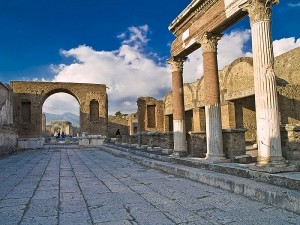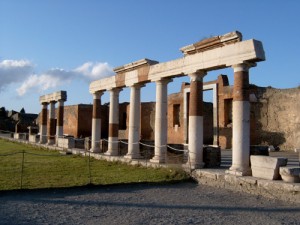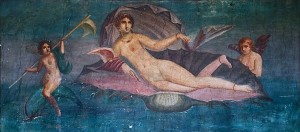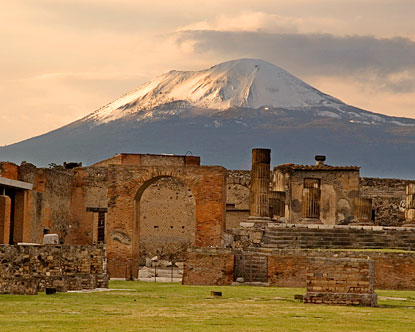Located in the province of Naples, the city of Pompeii is one of the world’s most visited archaeological sites and probably the best preserved of all Roman archaeological remains. It is unique in the world and no other ancient town has been brought to light so completely.

The town of Pompeii, Italy.
Originally an Etruscan and then a Samnite town, Pompeii was colonized by the Romans in 80 B.C. On a summer morning in the year 79 A.D. the nearby Mount Vesuvius erupted, burying the bustling city of Pompeii, along with Herculaneum and a number of villas in the surrounding area in layers of volcanic ash and lava. At the time of the eruption, experts estimate the town was home to about 35,000 souls and the volcanic explosion took the lives of the majority of the population.
The volcanic ash has preserved the remains for nearly 2000 years and kept streets, homes, furnishings, buildings and frescoes in almost perfect condition because of the lack of air and moisture. The ruins take visitors back in time to experience how people actually lived, worked and played. This ancient Roman settlement offers a real glimpse into everyday Roman life.
The site was discovered by chance during excavations for a canal during the 16th century. However, the ruins of the ancient town of Pompeii were not recognized for what they actually were until further investigations in the 18th century. Formal excavations started in the 19th century and continued steadily until most of the ancient town was uncovered from layers and layers of volcanic ash.
With an excavated area of 44 hectares, Pompeii has been a tourist attraction for over 250 years. Since its rediscovery, Pompeii has served as one of the most famous archaeological sites, where people can walk the ancients streets and view buildings, frescoes and even plaster body casts of people and animals that died during the catastrophic eruption of Mount Vesuvius.
Today Pompeii has UNESCO World Heritage Site status and is one of the most popular tourist attractions in Italy, with over 2 million visitors every year. A visit to the excavated ruins can be a really memorable part of any trip to Italy.

The Forum in Pompeii.
Attractions in Pompeii: Forum
Located at the intersection of two main streets, the Forum was the key open public space in the town and the buildings around it housed the city’s public administration. You can see the remains of the administrative building which was originally adorned with sculptures.
Attractions in Pompeii: Leisure Complex
Go on down the main street for two blocks, turn right and go down two blocks to the area including the Triangular Forum, the Doric Temple, the Large Theatre, the Small Theatre, the Gladiator Barracks and the Temple of Isis, which is considered as a kind of leisure complex for the town of Pompeii. Following an earthquake in 62 A.D., gladiators did their training in this area. You can see their cubicles around the outer walls of the courtyard where they trained. 18th-century archaeologists discovered bronze weapons, helmets and skeletons here.

The House of the Venus Marina in Pompeii, Italy.
Attractions in Pompeii: Via dell’Abbondanza
A stroll down the Via dell’Abbondanza allows you to get a glimpse of what Roman life was like. The House of Venus Marina is famed for the image of a lush garden painted on one of its inner walls. The Thermopolium of Vetutius Placidus was a kind of tavern.
Attractions in Pompeii: Northern Section
In the northern part of Pompeii you can see the house of the surgeon, where a number of surgical instruments, like catheters, scalpels and gynecological forceps, were discovered. This house also features wall paintings, some of which were probably painted only a few years before the town was obliterated and buried by the catastrophic eruption of Vesuvius.
Interested in one of the Best 1 Day Tour in Pompeii and Amalfi Coast from Rome city center ???
HighLights
- Explore Pompeii with an expert guide
- Panoramic drive down the Amalfi Coast
- Free time to discover beautiful Positano
- Travel in comfort with a small group (max 15)
Discover more about Pompei and Amalfi coast tour

